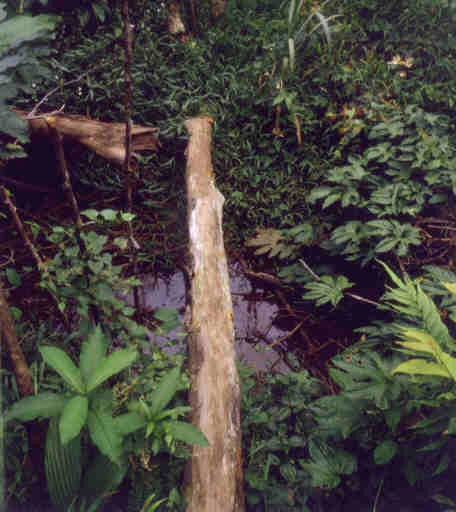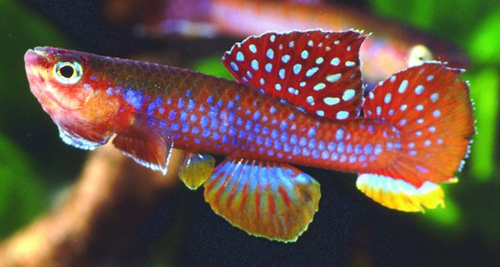| Meaning
of Name |
After
Georgiette Géry the wife of Dr.Géry. |
| First
Description |
Lambert
J.G. & Géry J. 1968. Poissons du
bassin de l'Ivindo III. Le genre Aphyosemion. Biologia
Gabonica 3 (1967) (4): 306-308, figure 3. |
| Size |
3.5 cm |
| Meristics |
D = 10-12, A = 10-12, ll = 26-28 (Lambert & Géry
1968) |
| Karyotype |
n = 18, A = 20 (Scheel 1981) |
| Sub-Genus |
Diapteron |
| Group |
|
| Synonyms |
- Aphyosemion georgiae georgiae
Böhm 1973
- Aphyosemion
(Diapteron) georgiae
Huber 1980
- Diapteron georgiae
Seegers 1980
|
Populations
- Essongville '95
- Makokou
- BDGB 04 / 12
- GBG 92 / 23
- GBG 92 / 30
- GWW 86 / 2
- GWW 86 / 3
- GWW 86 / 6 (?)
- LEC 93 / 2
- G 02/125
|
GWW 86 / 2 -
|

GWW 86-2
- Male
Photo
courtesy of Roberto Arbolea
|

GWW 86-2
- Female
Photo
courtesy of Roberto Arbolea
|
LEC 93 / 2 - Collected
8th January at 10.00 am in a small stream found by walking down a
trail off the road from Booué to Koumaméyong. Sympatric
species include A.sp.aff.cameronense
Phenotype 5, Characidae, Ctenopoma sp,
Barbus sp., shrimps.
Makokou -
|

A.georgiae collected
near to Makokou. Photo
courtesy of Ed Pürzl.
|
|
|
|
| Type
Locality |
A
pool close to Bélinga Camp in the Ivindo River basin, northern Gabon. This
area is in the site for a future railway station. http://www.exotics.net/dkg/steckbriefe/diapteron/gor/aphyosemion_georgiae_
typenfunfort_dkg_89-1_934x618.jpg |
| Distribution |
The area between Bélinga & Koumameyong, north
Gabon. |
| Habitat |
Small rainforest brooks which are mainly swampy
in the Ivindo River drainage.
Roland Numerich in February 1987 found a biotope
which was a small fast flowing stream whose character reportedly changes
every 200-300 metres. Numerich reported about 50 metres into the forest
from the bottom of the stream large chunks of rusty iron covering the
base of the biotope. The stream only started to look like a 'normal'
biotope of 50 cm of deep bog covered with mud & leaves with wood
& large tree roots after 150 metres. The stream was in a deep narrow
valley.
The sp. was collected near the banks between fibrous roots & overhanging
vegetation just below the surface. Found sympatric with A.cyanostictum.
Small stagnant pools near the stream were also
fished but no 'Diapteron' forms
were found.

At
this collection site near Ovan, Gabon
A.georgiae & A.cyanostictum
were collected. Photo:
Courtesy of Ed Pürzl. |
| Distinguishing
Characteristics |
|
| Colour/Pattern
Variability |
Low |
| History |
Gery collected the sp. in small streams in the
area around Belinga in 1964, approx 600 metres above sea level. He also
collected A.cyanostictum
Collected by Herzog & Bochtler in the summer of 1972 & took
back alive to Germany.
Collected by Roland Numerich in February 1987 between Belinga to Mayebut
on the Ivindo River. Also collected A.cyanostictum
& 2 sp. of Aphyosemion.
|
| Breeding
Notes |
Not recommended for the beginner. Males can be
aggressive towards females & plenty of plant/mop/peat fibre cover
is recommended. Fry are reportedly not harmed when small & these
can be taken off the surface & raised in a seperate tank with infusoria/Paramecium
as a first food.
They appear not to produce viable eggs until they reach 12 months of
age.
Growth
rate is slow with sexual maturity coming around 7-8 months. Jaroslav
Kadlec in BKA Newsletter No.268 (December 1987) gives the following breeding report:-
Water
should be soft, at least below 1·5 GH with a carbonate hardness under ·3KH.
Females were not seen to be prolific with a maximum yield of 10 per week. A lower
temperature than that in the maintenance tank should be used for breeding.
Breeding
groups of one male to 2-4 females or a larger breeding group at this ratio are
recomended.
A spawning medium should be peat fibre or fine leaved plants.
Mops did not prove successful.
Males in breeding condition can be aggressive
to females & a single female can be beaten to death.
Egg development can
be observed after 4-7 days at 23 - 25°C. Hatching occurs after 15 - 20 days.
It was noted that an acid water incubation prolongs the incubation time.. Temperature
also seems to affect this time.
Newly hatched fry measure 4·5 mm. First
food can be newly hatched brine shrimp or finely sifted Cyclops.
At one month they reached 1 cm & at 2 months they reached 16 - 18 mm. Males
can start to show colouration at around 10 weeks where they are noticeably larger
than females. Sexual maturity was noted at 14 - 16 weeks.
Water temperature
used to raise the young should be 22 - 24°C, a cooler temperature will slow
or even stop growth rate. |
| Diameter
of Egg |
1·3
- 1·4 mm. |
| Remarks |
Spawning adults can predate their eggs. Young fish have
been known to be cannibalistic to each other. |
